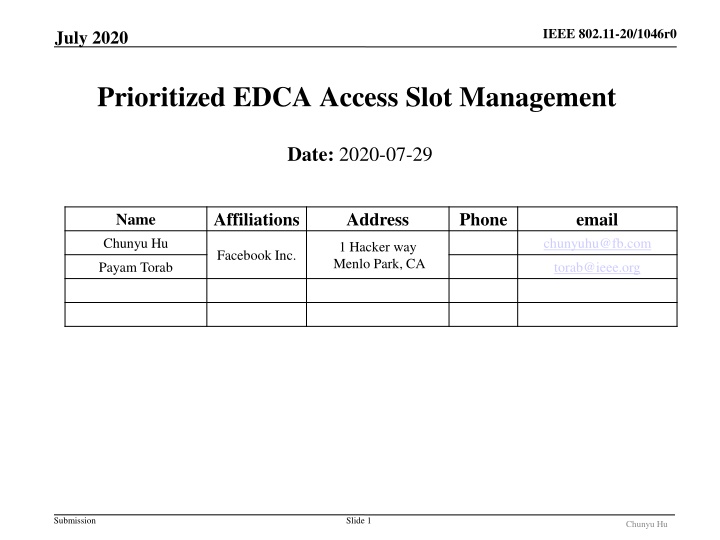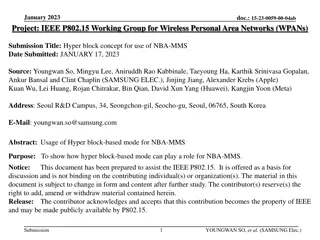
Prioritized EDCA Access Slot Management in IEEE 802.11-20
Explore the prioritized EDCA access slot management method proposed in IEEE 802.11-20/1046r0 for more predictable and prioritized channel access. The document discusses traffic classification, signaling options, slot management handshake, various client device scenarios, AP-STA cases, and considerations for TID/TSID/AC classification steps. Learn about differentiated channel access and quality of service streams over a single link.
Download Presentation

Please find below an Image/Link to download the presentation.
The content on the website is provided AS IS for your information and personal use only. It may not be sold, licensed, or shared on other websites without obtaining consent from the author. If you encounter any issues during the download, it is possible that the publisher has removed the file from their server.
You are allowed to download the files provided on this website for personal or commercial use, subject to the condition that they are used lawfully. All files are the property of their respective owners.
The content on the website is provided AS IS for your information and personal use only. It may not be sold, licensed, or shared on other websites without obtaining consent from the author.
E N D
Presentation Transcript
IEEE 802.11-20/1046r0 July 2020 Prioritized EDCA Access Slot Management Date: 2020-07-29 Affiliations Address Phone email Name Chunyu Hu chunyuhu@fb.com 1 Hacker way Menlo Park, CA Facebook Inc. Payam Torab torab@ieee.org Submission Slide 1 Chunyu Hu
IEEE 802.11-20/1046r0 July 2020 Abstract Background: new medium access method to provide more predictable, and prioritized channel access (11- 20/408r3) First part discusses traffic classification/signaling option to support it Second part discuss the slot management handshake Submission Slide 2 Chunyu Hu
IEEE 802.11-20/1046r0 July 2020 Various Client Device (non-AP STA) Scenarios Typically all traffic are destinated to AP STA o Note: TDLS / peer-to-peer links create multi-RA case, see NEXT slide / AP. Wearable devices: a device is designed to carry latency sensitive traffic o all traffic originated from/to this STA are desired to be prioritized (there can be some small portion of application mgmt/control traffic) A general computing device is running two types of traffic that falls into two categories: e.g. use BE/BK for regular traffic, and VI/VO for latency sensitive traffic; and they do not overlap o traffic originated from and/or to this STA, affiliated with specific TID(s), can be prioritized; and rest remain as regular traffic A general computing device is running multiple applications. Two of them are using the same VI, but one is latency sensitive (real-time interactive traffic, e.g. AR/VR), and one is regular (video subscription, e.g. Netflix) o (RA, TID1/AC) and (RA, TID2/AC) differentiate the access service provided to each of these flows, provided they map to different access priority Submission Slide 3 Chunyu Hu
IEEE 802.11-20/1046r0 July 2020 AP STA Case Traffic destinated to multiple clients (or the same client) with different DSCPs values co-exists o STA scenarios are special cases of AP o Note: DSCP has 6 bits, ranging in 0-63. Different DSCP values might map to a single TID and/or single AC AP has the following info available: o Packets from IP layer carries {RA, DSCP} DSCP maps to TSID / UP o Ether frame carries 802.1Q tag: 802.1Q tag UP 0-7 / TID o Additional info from STA: Attribute that can be attached to STA: operating mode Can differentiate among STAs in internal queue management Attribute that can be attached to the STA for a specific TID (for upstream) Downstream traffic might indicate low QoS priority which can be remapped to a higher priority based on a mirroring of similar traffic travelling in the upstream direction (MSCS) Submission Slide 4 Chunyu Hu
IEEE 802.11-20/1046r0 July 2020 Consideration in (New) TID/TSID/AC Classification steps: o Input: {RA, DSCP, 802.1Q UP} o {RA, TSID, UP} internal (logic) queues Tools: QoS mapping, TCLAS o {RA, TID/UP} internal queues Each (RA, TID) is associated with a BA agreement, and share a common sequence number space o Multiple TSIDs can be mapped into one TID, but doing so causes HOF blocking issue Question: at any given time period, for all applications running on a non-AP STA, as a source or sink node, do we need more than 8 or even 6 different quality of service streams over one link? o Does the link even capable of providing that many differentiated channel access? o (Answer: no, we don t really need to, and should avoid so if feasible/practical.) Submission Slide 5 Chunyu Hu
IEEE 802.11-20/1046r0 July 2020 Proposal Classify traffic to (RA, TID -- L-marker) o L-marker = 1: latency sensitive traffic, associated with whatever mechanism AP/network enables to differentiate from regular traffic o L-marker = 0: regular traffic o Constraint: for the same (RA, TID) pair, there is only one L-marker value for the corresponding traffic stream at any given time o *: if TID range to be used in 11be is extended beyond 7, then extend range as well. Options for signaling: 1. When establishing BA session, indicate if the associated TID (0-7) is desired to be served as latency sensitive traffic Cons: may still want to transfer without a BA session. If don t mind this limitation, could be a good option 2. Use a new IE following the Intra-Access Priority field that signals for alternateEDCA User priority bitmap (16 bits) : each bit, if set, indicates being mapped/requested to use prioritized service over regular traffic 3. Use signaling as part of slot request/response handshake frames Similar to ADDTS e.g. TBD Submission Slide 6 Chunyu Hu
IEEE 802.11-20/1046r0 July 2020 Preferred Option Options for signaling: 1. Create a slot assignment request/response frame exchange sequence 2. Create a field that has 16bits: bit x = 1, means TID x carries latency sensitive traffic Any TID can be latency sensitive traffic, and follows corresponding medium access rule per P-EDCA DSCP UP mapping can use any of existing mechanisms, namely: o QoS map o TCLAS (used in conjunct with ADDBA e.g., but not limited to) Note: TCLAS can be used in ADDBA Block Ack action/AddBA frame format Order Description 1 Category = 3 2 Bloack Ack Action 3 Dialog Token 4 BA param. set 5 BA Ack Tmout Expected operation flow: o Association, authentication o ADDBA (with TCLAS) o SLOT-ADD-REQ/RESP with per UP L-marker bitmap 6 BA SSN/ctl elements 7 GCR GA (O) 8 Multi-band (O) 9 TCLAS (O) Tab.9-361, PP1524 10 ADDBA Ext (O) Submission Slide 7 Chunyu Hu
IEEE 802.11-20/1046r0 July 2020 Examples Example 1: A STA marks any of 8 UPs/TIDs as latency sensitive, requesting corresponding service provided over the link Example 2: A STA marks a subset of UPs/TID 0-7 as latency sensitive Example 3: If traffic destinated to the same STA has both latency sensitive and regular traffic for the same AC, there are still at least 4 TID values for default/regular {BE,BK,VI,VO} traffic, the others (one or more) can be used for latency sensitive traffic. o QoS Mapping allows AP maps DSCP to UP with great flexibility o STA can also use TCLAS element in conjunction with ADDBA request to classify MSDU to desired TID/UP Submission Slide 8 Chunyu Hu
IEEE 802.11-20/1046r0 July 2020 Work Together with Prioritized EDCA Channel Access per 11-20/408 Traffic classified with {L-marker = 1} are transmitted over slot registered for prioritized access as described in 11-20/408 (next contribution is WIP) Traffic with {L-marker=0} follows regular EDCA access MAC switches transmit AC queues to serve queues of {L-marker=0} and {L-marker=1} multiplexed over time Submission Slide 9 Chunyu Hu






















